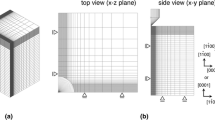Abstract
Knoop microhardness anisotropy measurements on the {100}-orientated In1−x Ga x As y P1−y /InP system have disclosed an appreciable variation in hardness behaviour across the composition range of the alloy. This paper relates these variations to changes in the directional fracture characteristics of the system. The qualitative investigation of both Vickers and Knoop indentation fracture has established the emergence of a secondary 〈100〉 cleavage direction at high values of the composition parameter, abovey ≅ 0.6. Furthermore, the number and extent of cracks emanating from indentations were seen to increase appreciably asy increases from 0 to 1. A quantitative analysis of Vickers indentation fracture in the quaternary system has indicated a marked dependence of fracture-related parameters on both the indentor orientation and composition. Fracture toughness values from ∼ 3.105 to ∼ 1.106 N m/12 have been derived using expressions from the literature. The marked change in Knoop microhardness anisotropy characteristics with increasingy in the In1−x Ga x As y P1−y /InP system has been partially correlated to the emergence of 〈100〉 cleavage and the general increase in indentation fracture, highlighted by the quantitative fracture measurements. Thus, it is concluded that even at very low indentation loads, the effect of fracture on the measured hardness of crystalline materials cannot be ignored.
Similar content being viewed by others
References
D. Y. Watts andA. F. W. Willoughby,J. Appl. Phys. 56 (1984) 1869.
Idem, Mater. Lett. 2 (1984) 355.
Idem, Proceedings 13th International Conference on Defects in Semiconductors, Coronado, California, edited by L. C. Kimmerling and J. M. Parsey, The Metallurgical Society of AIME, 12–17 August, 1984, pp. 1187–94.
D. Brasen,J. Mater. Sci. 11 (1976) 791.
Idem, ibid. 13 (1978) 1776.
D. Y. Watts, PhD thesis (1986).
F. W. Daniels andC. G. Dunn,Trans. Amer. Soc. Met. 41 (1949) 419.
C. Feng andC. Elbaum,Trans. Met. Soc. AIME 212 (1958) 47.
C. A. Brookes, J. B. O'Neill andB. A. W. Redfern,Proc. Roy. Soc. A 322 (1971) 73.
M. Garfinkle andR. G. Garlick,Trans. Met. Soc. AIME 242 (1968) 809.
G. Y. Chin andW. A. Hargreaves, in “The Science of Hardness testing and its research applications”, edited by J. H. Westbrook and H. Conrad, Symposium Proceedings (American Society of Metals, Detroit, 1971) ch. 12.
S. Komiya andK. Nakajima,J. Crystal Growth 48 (1980) 403.
O. Ueda, S. Komiya, S. Yamazaki, Y. Kishi, I. Umebo andT. Kotani,Jpn J. Appl. Phys. 23 (1984) 836.
J. A. Lourenco,J. Electrochem. Soc. 131 (1984) 1914.
D. Tabor,Rev. Phys. Technol. 1 (1970) 145.
B. R. Lawn andT. R. Wilshaw,J. Mater. Sci. 10 (1975) 1049.
C. A. Brookes,Nature London 228 (1970) 660.
H. Hertz,J. Reine Angew Matt. 92 (1881) 156.
9J. Boussinesq, “Application des Potentials a l'Etude d'equilibre et du mouvement des solides elastiques” (Gauthier-Villars, Paris, 1885).
S. Palmqvist,Arch. Eisenhuttenw. 33 (1962) 629.
M. T. Huber,Ann. Physik 14 (1904) 153.
H. E.Exner,Trans. Met. Soc. AIME 245 (1969) 677.
B. R. Lawn andM. V. Swain,J. Mater. Sci. 10 (1975) 113.
B. R. Lawn andE. R. Fuller,ibid. 10 (1975) 2016.
B. J. Hockey andB. R. Lawn,ibid. 10 (1975) 1275.
D. B. Marshall andB. R. Lawn,ibid. 14 (1979) 2001.
B. R. Lawn andD. B. Marshall,J. Amer. Ceram. Soc. 62 (1978) 347.
S. G. Roberts, P. Pirouz andP. B. Hirsch,J. Mater. Sci. 20 (1985) 1739.
B. R. Lawn andA. G. Evans,ibid. 12 (1977) 2195.
A. G. Evans andE. A. Charles,J. Amer. Ceram. Soc. 59 (1976) 371.
I. H. Wawra,Blech Rohre 8 (1975) 333.
M. Beuberger, (ed.) “Handbook of Electronic Materials”, Vol. 2 (IFI/Plenum, New York, 1971).
Author information
Authors and Affiliations
Rights and permissions
About this article
Cite this article
Watts, D.Y., Willoughby, A.F.W. Indentation fracture in the In1−x Ga x As y P1−y /InP system and its effect on microhardness anisotropy characteristics. J Mater Sci 23, 272–280 (1988). https://doi.org/10.1007/BF01174065
Received:
Accepted:
Issue Date:
DOI: https://doi.org/10.1007/BF01174065




